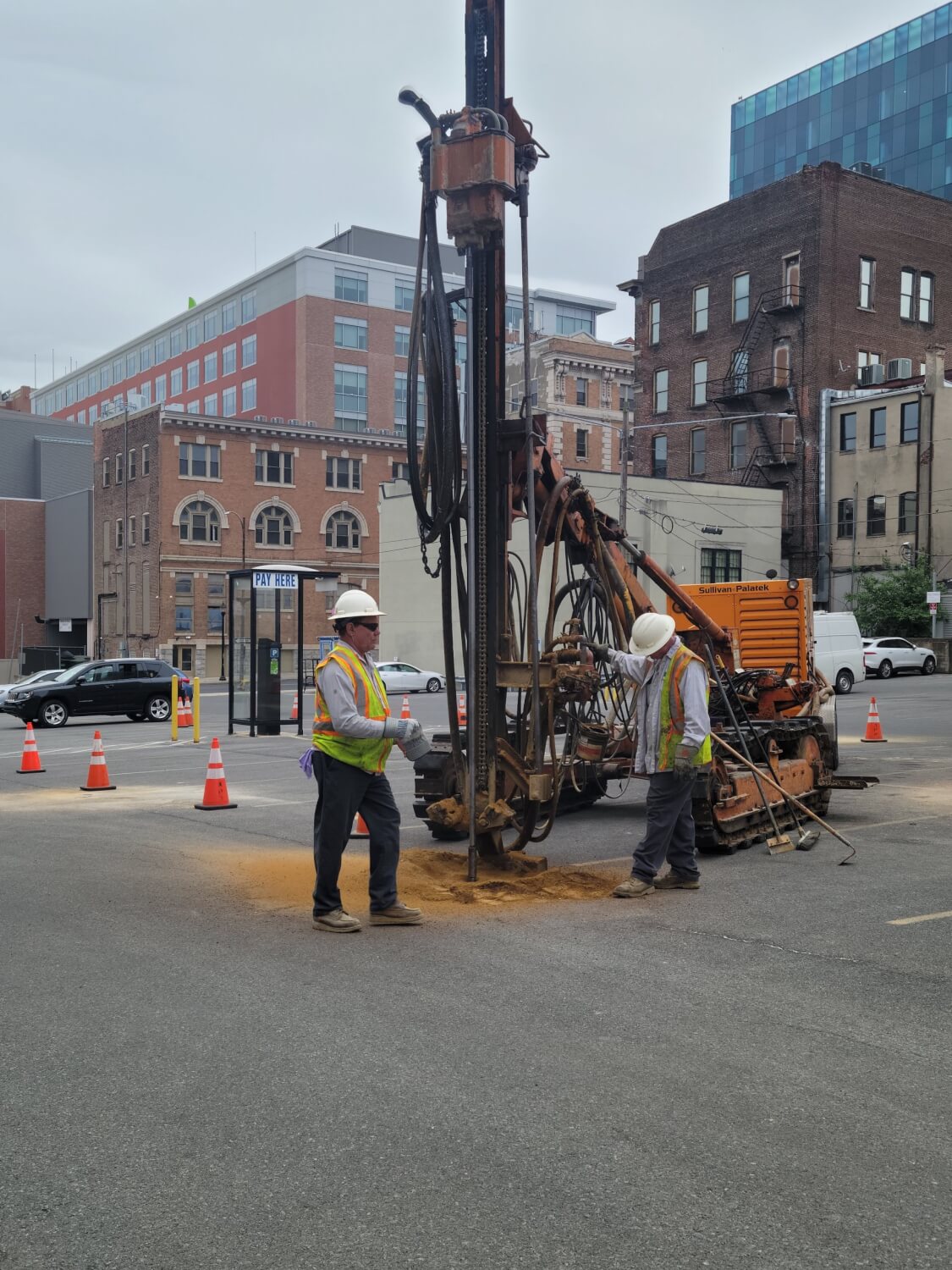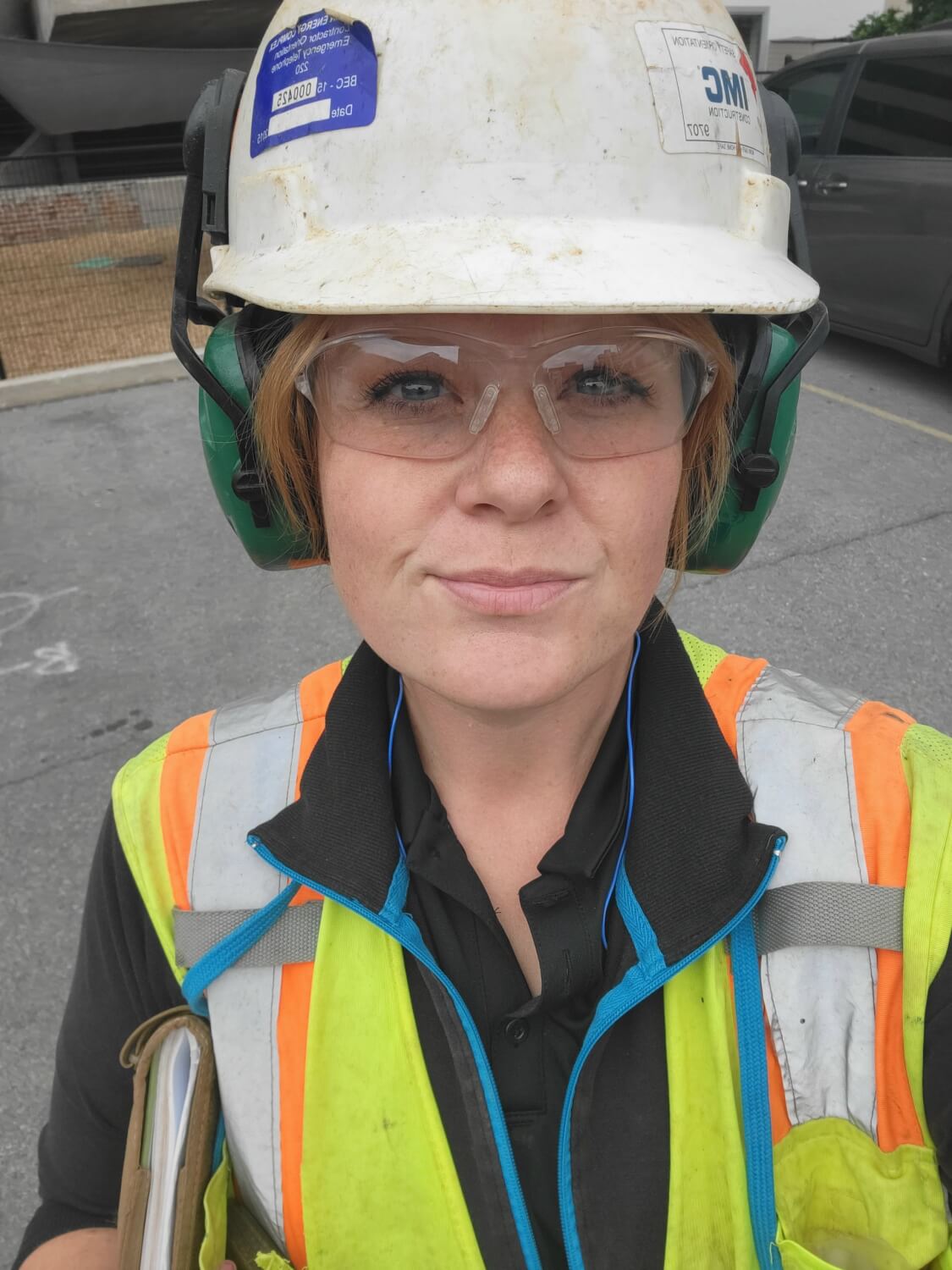Notice: We are temporarily closed as we move locations. Visit the new Da Vinci Science Center at PPL Pavilion beginning May 22.
July 28, 2021
 Colleen Limbert, a Staff Soil Scientist, and the team at Geo-Technology Associates are engaged in the project early on. They use drill rigs to drill borings and rock probes into the ground in search of underlying bedrock.
Colleen Limbert, a Staff Soil Scientist, and the team at Geo-Technology Associates are engaged in the project early on. They use drill rigs to drill borings and rock probes into the ground in search of underlying bedrock.
Colleen is on site to oversee this process. What are they testing for? How deep they need to drill before they hit bedrock and what the quality of the bedrock is for micro piles that will be drilled to support columns for the new building. Pretty cool stuff, right?!
So how does one become a soil scientist? Read on to find out.
What is your position at GTA?
I am a Staff Soil Scientist within GTA’s Geotechnical division. I work on small to large sites (from 20 to 120 acres) and study, observe and test the soils and rocks for strength (for example to hold up a building or retaining wall). I also complete infiltration testing to help design ways to put storm water back into the ground instead of flooding our creeks and rivers. I use my artistic side to 3-D model the underground layers and how they correspond to the surface and how best to use the site for the desired purpose, ie. new developments/construction or the installation of nature trails, etc.
Did you always know you would be a scientist?
Yes! I always knew I would be a scientist. I imagined having my name lettered on a laboratory door when I was in middle school. I followed a science class track throughout high school, as well as the Arts. After school I bartended for a handful of years, until I realized I was bored and wanted to make a difference somewhere in nature around me.
I started my college career at the age of 24 at Montgomery County Community College, where I took general studies with an emphasis in chemistry, physics and earth sciences. I received my Associates in Science and then went to Buck Community to further my studies in chemistry and math. It took me three tries to pass Calculus (!); but studying and receiving tutoring outside of my classes helped. I took a few years off, to work and save money and then applied to Delaware Valley University in 2014 to finish my Bachelors.
Why soil?
I started in Delaware Valley University’s chemistry program, however I took a Soils class my first semester and fell in love. Soils combines my love of science and the Earth (I was raised on Captain Planet and The Lorax) but also brought in my artistic side. Changing over to the soils track also satisfied my need to not be in an office chair 100% of the time and I enjoy and appreciate the physical aspect of my job.
I’m proud of my chosen field, that I have the opportunity to grow my certifications, like recently receiving my Wetland Delineation Certification and to continue to hone my skills, and maybe to affect my tiny little corner of the world.
How does your passion for art factor in?
First, I feel like art shows up in science all the time in the divine design of the world around us. Like how pineapples scales and a flower’s petals include the Fibonacci sequence or how galaxies and the rods and cones of our eyes mimic each other. In art classes, we are taught to recognize patterns and flow, light and shadow, and how to build paints on a canvas to achieve the desired texture and look. Nature does the same thing. When I am assessing a property’s landscape, I use these artful observations to see where the natural drainage occurs, to observe a slight change in vegetation that may indicate a wetland or karst feature, or where micro-topographical changes indicate specific underground changes in soils, rock and water. Being able to visualize an entire landscapes unseen and underground morphology, helps us to decide the feasibility of future land use, without digging up every inch of the Earth!
What is your typical day like?
My day usually starts with emails and catching up with co-workers, as we do work as a team, scientists and engineers together. Field work is 70% of my week and then I follow up in the office with data input and technical report writing, which is then submitted to our clients, contractors and developers.
Do you face challenges as a woman in this field?
Yes, there are challenges to being a woman in a field that is a majority male. The looks that say, “you can’t do this or oh man, I have to take directions from a woman?” However, even the toughest Philly Union contractors show respect when they see I work hard, carry my own tools (about 100 lbs. of material to each soil pit!) and am an even-keeled, confident and a knowledgeable site manager. It took a bit of time to speak for myself and gain this confidence, but I wouldn’t change it for the world. Even in my scientific college classes, men outnumbered women, however, I often found a group of women that were fully engaged in their STEM studies, and it was great to have that support in life and in school.
I would love to see more young women choose the STEM career path. I would tell them, don’t be afraid and realize that as women, we stand just as tall, just as confident and just as capable as any other human.
Da Vinci Science Center at PPL Pavilion
815 W. Hamilton Street
Allentown, PA 18101
Opening May 22, 2024
Mon-Sun 10 a.m.-5 p.m.
Directions & Parking
This project was financed by a grant from
